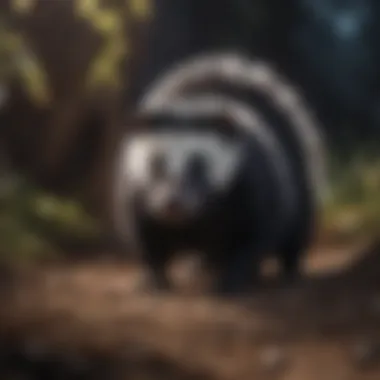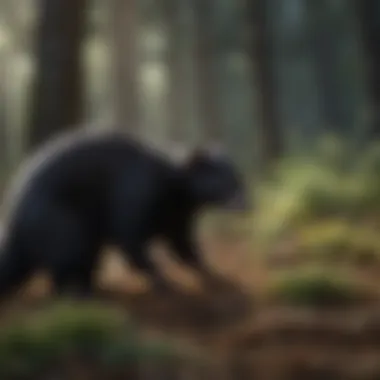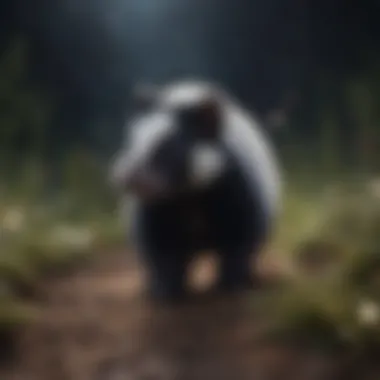Exploring the Nocturnal Behavior of Skunks and Their Fascinating Nighttime Habits


Nature Topic Overview
Skunks are highly intriguing creatures known for their distinct black and white colors and, more notably, their potent defensive mechanism - spraying a foul-smelling liquid when threatened. One aspect that sets them apart from other animals is their nocturnal nature. This article delves deep into the nocturnal behavior of skunks, shedding light on the reasons behind their preference for nighttime activities. By understanding why skunks are nocturnal, we gain valuable insights into their ecology and their role in the ecosystem.
Fun Facts and Trivia
Skunks have a unique way of warning potential threats – before they resort to spraying, they stomp their feet, hiss, and raise their tail as a last line of defense. Despite their reputation, skunks are generally quite docile creatures and only resort to spraying as a defense mechanism when they feel threatened. Their spray can reach up to 10 feet and has a strong, unpleasant odor that can linger for days. This nocturnal animal has sharp claws for digging and can climb trees with ease, showcasing their versatility in various habitats.
Wildlife Explorations
Skunks belong to the family Mephitidae and are further categorized into different species, including the striped skunk, spotted skunk, and hooded skunk. Each species has unique characteristics, such as coat patterns and sizes, but they all share a common nocturnal behavior. Skunks primarily inhabit woodland areas or grasslands, where they can dig burrows to seek shelter during the day. They are omnivores, feeding on a diverse diet that includes insects, small mammals, fruits, and plants.
Environmental Awareness
Understanding the importance of skunks in the ecosystem is crucial for promoting conservation and sustainability. Skunks play a vital role in controlling insect populations, particularly harmful pests like grubs and beetles. By keeping these populations in check, skunks help maintain the ecological balance within their habitats. Encouraging children to appreciate the role of skunks in nature can foster a sense of responsibility towards wildlife conservation and encourage sustainable practices in their daily lives.
DIY Nature Activities
Engaging children in hands-on activities related to skunks can deepen their understanding and appreciation for these creatures. Parents and educators can organize nature-inspired crafts where children can create skunk masks using recycled materials. Additionally, setting up a 'sensory exploration station' with scents mimicking a skunk's spray can provide a fun and interactive learning experience. Outdoor explorations can involve identifying skunk habitats and learning about the signs of skunk presence, promoting a sense of discovery and curiosity about the natural world.
Introduction
Skunks, known for their distinctive black and white fur and potent spray, possess intriguing behaviors that pique the curiosity of nature enthusiasts. The nocturnal nature of skunks, characterized by their heightened activity during the night, serves as a focal point in unraveling the unique lifestyle of these creatures. Understanding the nightly routines of skunks unveils a realm of mystery and adaptation that showcases their resilience in the face of diverse ecological challenges. This article embarks on a captivating journey into the world of skunks, shedding light on their secretive nocturnal realm and delving deep into the reasons behind their preference for nighttime activities.
In the realm of zoology and ecology, exploring the behavioral patterns of skunks under moonlit skies offers valuable insights into the intricate dynamics of the animal kingdom. The adaptation of skunks to nocturnal life presents a fascinating study in survival strategies, as they navigate the darkness with remarkable precision and adeptness in search of sustenance and shelter. By unraveling the enigmatic allure of nocturnality in skunks, we unravel the threads of nature's tapestry, witnessing firsthand the remarkable ways in which these creatures have evolved to thrive under the cover of night. Prepare to embark on a journey of discovery as we unveil the mysteries of skunks' nocturnal existence and illuminate the paths they tread under the cloak of darkness.
What are Skunks?
Skunks are intriguing creatures that play a vital role in the ecosystem due to their unique characteristics. From their distinctive black and white fur to their well-known defense mechanism, skunks are a subject of fascination for many. By exploring the topic of 'What are Skunks?' in this article, we aim to delve into the aspects that make skunks stand out in the animal kingdom.


Skunks' physical characteristics are a blend of uniqueness and functionality. With their distinct coloration, they serve as a visual warning to potential predators about their potent defense mechanism. Skunks possess sharp claws for digging and formidable teeth for consuming a diverse diet. Their fur is not just for aesthetics but also aids in camouflaging them in their natural habitat, allowing them to move stealthily. Understanding the physical attributes of skunks is crucial in appreciating how they have adapted to survive in various environments.
Physical Characteristics
Skunks exhibit a range of physical traits that distinguish them from other creatures. Their furry bodies are typically black with prominent white stripes, serving as a distinctive color pattern that warns predators of their defensive capabilities. Skunks have sharp claws that enable them to dig for food efficiently and create shelter. Additionally, their teeth are well-suited for an omnivorous diet, reflecting their adaptability in obtaining nutrients from various food sources. The fur of skunks not only provides insulation but also helps them blend into their surroundings, enhancing their chances of successful foraging and evading danger.
In essence, understanding the physical characteristics of skunks offers insights into their evolutionary history and ecological niche. By comprehending the unique features that define skunks, we can better grasp their behavior, habitat preferences, and interactions with other species.
Skunks' Behavior
Skunks' behavior is a critical aspect that sheds light on the nocturnal nature of these intriguing creatures. Understanding the behavior patterns of skunks provides valuable insights into their ecology and role within the ecosystem. By observing how skunks behave, researchers can decipher the reasons behind their nocturnal tendencies, their dietary habits, and the mechanisms they employ for protection.
Nocturnal Behavior
The Concept of Nocturnality
Delving into the concept of nocturnality unveils the innate inclination of skunks towards nighttime activities. This adaptation enables skunks to avoid potential predators, maximize their foraging opportunities when competition is low, and utilize the cover of darkness for movement. The unique feature of nocturnality in skunks lies in their heightened senses during the night, enhancing their ability to hunt and navigate effectively under low light conditions. While there are advantages to being nocturnal, such as reduced threat from diurnal predators, there are also disadvantages, including limited visibility for certain activities.
Adaptations for Nighttime Activity
Skunks have evolved remarkable adaptations to thrive during nighttime pursuits. Their keen sense of smell allows them to locate food sources in the dark, while their excellent hearing aids in detecting potential threats. Skunks' nocturnal vision, though not as precise as their diurnal counterparts, is adapted for low-light conditions, granting them a degree of visibility during their night-time ventures. These adaptations bolster their survival chances by enhancing their efficiency in locating food, communicating with conspecifics, and defending themselves against nocturnal predators.
Dietary Habits
Skunks' dietary habits play a crucial role in their nocturnal behavior. Their choice of food sources influences their nocturnal foraging expeditions and interactions within their ecosystem. By exploring the dietary preferences of skunks, one can unravel their foraging strategies, the impact of their food choices on their nocturnal behavior, and their role in regulating prey populations within their environment.
Reasons Behind Nocturnal Nature
Skunks, known for their distinctive black and white markings, possess intriguing behavioral patterns that revolve around their nocturnal nature. Their preference for nighttime activities is rooted in a complex interplay of biological and ecological factors that have evolved over time. Understanding the reasons behind skunks' nocturnal behavior is crucial in unraveling the dynamics of their survival strategy. By delving into these reasons, we gain a deeper appreciation for the intricacies of wildlife adaptation to different environments. It is not merely a matter of convenience; nocturnality offers skunks a competitive edge in the ecosystem.
The Evolutionary Advantage of Nocturnality


In the realm of wildlife, the concept of nocturnality represents a strategic adaptation to optimize survival under the cover of darkness. Skunks, with their keen sense of smell and impressive auditory capabilities, navigate their surroundings with remarkable precision during the night. This mode of operation allows skunks to avoid potential predators and forage for food more effectively. Their ability to thrive in low-light conditions is a testament to their evolutionary journey shaped by the demands of their habitat.
Enhanced Foraging Opportunities
One of the standout benefits driving skunks towards nocturnal activity is the abundance of opportunities for foraging during the night. In the cover of darkness, skunks capitalize on the reduced competition from diurnal species, enabling them to secure essential food resources without undue interference. This behavioral strategy, honed through generations of adaptation, ensures a steady food supply essential for their sustenance and reproductive success.
Limiting Exposure to Threats
In the wild, survival hinges on a delicate balance between securing resources and avoiding dangers. For skunks, being active at night minimizes their exposure to predators due to reduced visibility. The cloak of darkness offers a protective shield, affording skunks a level of safety unavailable during the daylight hours. By limiting their vulnerability to threats, skunks can allocate more energy towards essential tasks like feeding and reproduction.
Conclusively, the reasons behind skunks' nocturnal nature reflect a nuanced synergy between biological imperatives and environmental influences. Their ability to thrive in the cover of night underscores the resilience and adaptability of these fascinating creatures, shedding light on the intricate tapestry of wildlife behavior.
Interactions with Other Animals
When considering the nocturnal nature of skunks, it is imperative to understand their interactions with other animals. Skunks play a unique role in the ecosystem, influencing various species around them. These interactions are not only intriguing but also essential for maintaining ecological balance. By delving into how skunks interact with other creatures, we can uncover a broader perspective on their significance in the wildlife community.
Mutualistic Relationships
Skunks engage in mutualistic relationships with certain animals, such as birds that feed on insects that skunks disturb while foraging. This symbiotic interaction benefits both parties involved, showcasing the complex web of connections within nature. Understanding these mutualistic dynamics sheds light on how skunks contribute to the overall health of their environment.
Competitive Interactions
Moreover, skunks face competition from other nocturnal creatures like raccoons and opossums for resources such as food and shelter. These competitive interactions highlight the challenges skunks encounter in their nightly activities. Studying these dynamics provides insights into how wildlife coexist and adapt in shared habitats, adding a layer of depth to our understanding of ecosystem dynamics.
Prey-Predator Relationships
Skunks also participate in prey-predator relationships, where they may fall victim to larger predators such as coyotes or owls. This aspect of their interactions underscores the vulnerabilities skunks face in their environment. Analyzing these relationships elucidates the predation pressures that shape skunk behavior and distribution, offering a glimpse into the harsh realities of wildlife survival.
Conclusion


Protection Mechanisms
Skunks possess a fascinating array of protection mechanisms that play a crucial role in their survival within the ecosystem. These mechanisms are not mere adaptations but rather intricate strategies honed through evolution. Skunks are known for their distinctive defense mechanism - spraying a noxious liquid as a form of protection. This defense tactic is employed when skunks feel threatened, serving as a potent deterrent against predators. The chemical composition of the spray is such that it can cause discomfort and temporary blindness in adversaries, making it a highly effective defense strategy. Additionally, skunks also resort to warning displays before opting for spraying, giving a chance for predators to retreat. Understanding these protection mechanisms provides valuable insights into the behavior and survival strategies of skunks.
Spraying as a Defense Mechanism
One of the most iconic defense mechanisms of skunks is their ability to spray a pungent liquid as a means of defense. This spray is emitted from anal glands located near the base of the tail. Skunks have remarkable accuracy in spraying the liquid up to a distance of about 3 meters, which aids them in effectively deterring predators. The odor of the spray is strong and long-lasting, serving as a warning sign to potential threats in the vicinity. Skunks typically arch their backs and raise their tails when preparing to spray, signaling their readiness to deploy this defense mechanism. Understanding the intricacies of spraying as a defense mechanism sheds light on the unique adaptations that skunks have developed for survival in their natural habitat.
Skunk Species Varieties
Skunks, fascinating creatures of the night, come in different varieties that showcase unique characteristics and adaptations suited to various environments. Understanding the intricacies of skunk species varieties is paramount in unraveling the biodiversity within the skunk population. This section aims to delve deep into the diverse world of skunk species, shedding light on the significance of these variations in the broader context of nocturnal behavior and ecological interactions.
Skunk species varieties encompass a range of subspecies that exhibit differences in physical attributes, behavioral patterns, and habitat preferences. From the Striped Skunk to the Spotted Skunk, each type presents a distinct combination of coloration and markings, providing researchers and enthusiasts with valuable insights into the evolutionary pathways of skunks across different regions. Exploring the nuances of these varieties not only enriches our understanding of skunk biology but also underscores the intricate adaptations that have enabled these creatures to thrive in their respective ecosystems.
The importance of skunk species varieties in this article lies in their relevance to the discussion on skunks' nocturnal nature. By dissecting the unique traits of each subspecies, we can unravel the underlying factors influencing their nocturnal behavior, such as predatory pressures, resource availability, and interspecies competition. Through a detailed analysis of skunk species varieties, we aim to contextualize the nocturnal habits of these creatures within the framework of evolutionary biology and ecological specialization.
Furthermore, examining skunk species varieties offers valuable insights into conservation efforts aimed at preserving these intriguing animals and safeguarding their habitats. By recognizing the distinct needs of different skunk subspecies, conservationists can develop targeted strategies to mitigate threats, promote genetic diversity, and ensure the long-term survival of these vital members of the ecosystem. Thus, understanding skunk species varieties not only enriches our scientific knowledge but also informs practical initiatives aimed at fostering coexistence between humans and wildlife in an ever-changing world.
Human Interaction and Awareness
Human interaction and awareness play a crucial role in understanding and coexisting harmoniously with skunks. Skunks, although often associated with their defensive spray, are fascinating creatures that offer valuable insights into wildlife behavior. Educating the public about skunks is essential to dispel myths and misconceptions surrounding these animals. By promoting awareness, we can foster respect for skunks and encourage responsible behavior in their presence.
Educating Children
Encouraging children to learn about skunks from an early age is instrumental in instilling empathy and understanding for these nocturnal creatures. Teaching kids about skunks can promote curiosity and appreciation for wildlife diversity. It also aids in nurturing a sense of environmental stewardship among the younger generation, paving the way for future conservation efforts.
Community Outreach
Engaging with local communities through awareness campaigns and educational initiatives can help foster a positive relationship between humans and skunks. Organizing workshops, seminars, and outreach programs can debunk common misconceptions and highlight the significance of skunks in the ecosystem. By involving the community in conservation efforts, we create a shared responsibility towards preserving wildlife habitats.
Behavioral Studies
Conducting behavioral studies on skunks allows researchers to gain valuable insights into their habits and interactions with humans. By understanding skunk behavior patterns, we can develop strategies to mitigate conflicts and coexist peacefully. Research findings can inform policies and guidelines for managing skunk populations in urban and rural environments, ensuring a balanced ecosystem for both humans and wildlife.
Public Safety Measures
Promoting public safety measures when encountering skunks is essential to prevent conflicts and minimize risks. Educating the public on handling skunk encounters safely can reduce incidents of aggression and potential harm to both humans and skunks. By advocating for respectful cohabitation practices, we can protect skunks and mitigate negative interactions between humans and wildlife.







